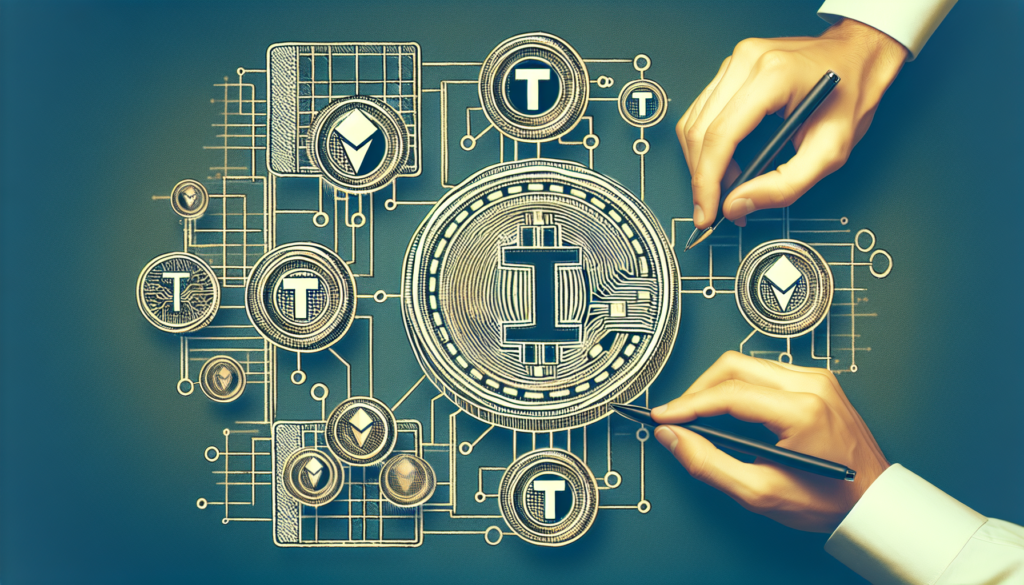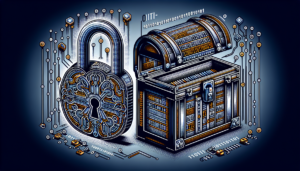In “Understanding Tokenization: A Comprehensive Guide,” you’ll embark on a journey to demystify the concept of tokenization. Whether you’re a tech enthusiast or just eager to learn more about the world of cybersecurity, this guide offers a comprehensive overview of tokenization and its practical applications. From understanding the basics of tokenization to exploring its role in data security and payment processing, you’ll gain valuable insights that will empower you to navigate the digital landscape with confidence. Join us as we unravel the complexities of tokenization and unveil its potential to revolutionize data protection.

What is Tokenization?
Tokenization is a method of data protection that involves replacing sensitive information with a unique identifier called a token. The token retains some characteristics of the original data but does not reveal the actual sensitive information. This process ensures that sensitive data is securely stored and transmitted without exposing it to potential threats.
Definition of Tokenization
In simple terms, tokenization refers to the process of substituting sensitive data with a non-sensitive equivalent, known as a token. The token retains a reference to the original data, allowing it to be used for certain authorized purposes while keeping the sensitive information hidden.
How Tokenization Works
In tokenization, the sensitive data is securely stored in a separate component called a token vault. When a request to access or use the original data is made, the token is used as a reference to retrieve the corresponding information from the vault. The token itself contains no meaningful information and is useless to unauthorized individuals.
Advantages of Tokenization
Tokenization offers several advantages for organizations looking to secure their sensitive data.
Increased Security
Tokenization significantly enhances security by ensuring that sensitive data is not exposed. Even if a token gets intercepted, it is useless without access to the token vault. This mitigates the risks associated with data breaches and unauthorized access.
Reduced Compliance Burden
By tokenizing sensitive data, organizations can reduce their compliance burden. Tokenization techniques can help organizations meet the requirements of various data protection regulations, such as the Payment Card Industry Data Security Standard (PCI DSS), without having to store sensitive data in their systems.
Enhanced Customer Experience
Tokenization can also lead to an improved customer experience. Since sensitive data is no longer stored in multiple systems, customers can have greater confidence in the security of their information. Additionally, tokenization can streamline payment processes, making transactions faster and more convenient for customers.

Tokenization Techniques
There are different tokenization techniques that organizations can employ based on their specific needs and requirements.
Format-Preserving Tokenization
Format-preserving tokenization involves creating tokens that retain the same format and structure as the original data. For example, a 16-digit credit card number could be tokenized into another 16-digit number. This technique is useful when maintaining compatibility with existing systems or processes that rely on specific data formats.
Hash-Based Tokenization
Hash-based tokenization involves using mathematical algorithms to generate unique tokens from sensitive data. The algorithms create irreversible transformations of the original data, ensuring that it cannot be reverse-engineered from the token. This technique provides an additional layer of security but may result in tokens that do not resemble the original data in any way.
Randomized Tokenization
Randomized tokenization involves generating tokens with no specific relationship to the original data. These tokens are randomly generated and have no discernible pattern or structure. While this technique provides strong security, it may require additional mapping or lookup processes to associate tokens with the original data when needed.
Tokenization vs. Encryption
Tokenization and encryption are both methods used to secure sensitive data, but they differ in how they achieve that goal.
Differences between Tokenization and Encryption
Encryption involves transforming sensitive data into unreadable ciphertext using an encryption key. To access the original data, the ciphertext must be decrypted using a corresponding decryption key. In contrast, tokenization replaces sensitive data with a token and stores the original data in a secure vault. Tokenization does not involve the use of encryption keys but relies on tokenization keys to retrieve the original data.
Comparing Security and Performance
Both tokenization and encryption provide robust security for sensitive data. However, tokenization offers advantages in terms of performance and scalability. Tokenization eliminates the need for decrypting and re-encrypting data, making it faster and more efficient for data retrieval. Additionally, tokenization allows for easier data storage and management since tokens do not require the same level of protection as encryption keys.

Common Use Cases for Tokenization
Tokenization is widely used in various industries and scenarios to protect sensitive data and improve security.
Payment Card Industry (PCI) Compliance
Tokenization plays a crucial role in achieving PCI compliance for organizations that handle payment card data. By tokenizing credit card numbers and other sensitive information, organizations can reduce the scope of their PCI compliance efforts and minimize the risks associated with storing such data.
Data Storage and Cloud Security
Whether it’s on-premises or in the cloud, organizations need to secure their data storage systems. Tokenization provides an effective method for safeguarding data in databases or cloud environments. By tokenizing sensitive information, organizations can mitigate the risks of unauthorized access and data breaches.
Digital Wallets and Mobile Payments
Tokenization is also widely utilized in digital wallets and mobile payment applications to enhance security during transactions. When a user adds their payment card to a digital wallet, the card details are tokenized. These tokens are then used for transactions, ensuring that the user’s card information is not exposed in the payment process.
Implementing Tokenization in Organizations
To implement tokenization effectively, organizations need to follow certain steps and establish robust processes.
Identifying Sensitive Data
The first step in implementing tokenization is to identify the sensitive data that needs to be protected. This typically includes personally identifiable information (PII), financial information, and any other data that could pose a risk if exposed.
Tokenization Process Flow
Organizations need to establish a clear process flow for tokenization. This includes defining how data will be tokenized, stored, and retrieved. The process should incorporate appropriate security controls to ensure the integrity and confidentiality of the original data and tokens.
Token Management Systems
To effectively manage tokens, organizations should implement token management systems. These systems track the lifecycle of tokens, including token generation, storage, retrieval, and expiration. Robust token management systems also provide audit trails, access controls, and the ability to revoke or replace tokens when necessary.

Challenges and Considerations
Despite its benefits, implementing tokenization can present certain challenges and considerations for organizations.
Integration with Legacy Systems
One challenge organizations may face is integrating tokenization with legacy systems that were not originally designed to work with tokenized data. Retrofitting existing systems to work with tokens can require careful planning and configuration to ensure seamless functionality.
Key Management and Rotation
Proper key management is crucial for tokenization. Organizations need to establish secure processes for generating and managing tokenization keys. Additionally, key rotation practices should be implemented to minimize the potential impact of compromised keys and enhance overall security.
Data Migration and Token Mapping
When migrating data to new systems or platforms, organizations need to consider the mapping of existing tokens to their corresponding original data. This ensures that tokens can be properly associated with the correct information in the new environment. Careful planning and testing are essential to avoid data loss or inconsistencies during the migration process.
Tokenization Best Practices
To maximize the effectiveness of tokenization, organizations should follow best practices in their implementation and maintenance strategies.
Protecting Tokenization Keys
Tokenization keys should be treated with the same level of care as encryption keys. Secure storage, strong access controls, and regular key rotation should be implemented to protect tokenization keys from unauthorized access and potential misuse.
Monitoring and Auditing Token Usage
Continuous monitoring and auditing of token usage is essential to detect any anomalies or unauthorized activities. Organizations should establish robust logging and auditing mechanisms to track and analyze token usage, enabling them to quickly identify and respond to any potential breaches or misuse.
Regularly Updating Tokenization Solutions
Tokenization solutions should be regularly reviewed and updated to incorporate the latest security enhancements and address any emerging threats. It is important to stay informed about advancements in tokenization technology and evolving best practices to ensure optimal data protection.

Regulatory Compliance and Tokenization
Tokenization can help organizations achieve compliance with various data protection regulations.
General Data Protection Regulation (GDPR)
Tokenization can assist organizations in complying with the GDPR’s requirements for protecting personal data. By tokenizing sensitive information, organizations can minimize the risks of unauthorized access, data breaches, and noncompliance with data protection principles.
Payment Card Industry Data Security Standard (PCI DSS)
Tokenization is an approved method for achieving PCI DSS compliance. By tokenizing payment card data, organizations can reduce the scope of their compliance efforts and ensure that sensitive cardholder information is protected throughout the payment process.
Health Insurance Portability and Accountability Act (HIPAA)
Tokenization can also support compliance with HIPAA requirements for protecting patient health information. By tokenizing sensitive patient data, healthcare organizations can minimize the risks associated with storing and transmitting such information, reducing the likelihood of unauthorized access and data breaches.
Emerging Trends in Tokenization
The field of tokenization continues to evolve, and several emerging trends offer new possibilities and challenges.
Blockchain-based Tokenization
Blockchain technology provides a decentralized and immutable ledger, making it an attractive option for tokenization. The use of blockchain-based tokenization can further enhance the security and integrity of tokenized data by leveraging the inherent properties of blockchain, such as transparency and immutability.
Multi-Cloud Tokenization
As organizations increasingly adopt multi-cloud environments, the need for consistent and secure tokenization across different cloud platforms becomes important. Multi-cloud tokenization ensures that data remains protected and accessible regardless of the cloud service provider being used.
Tokenization in Internet of Things (IoT)
The growth of the IoT presents new challenges for data protection, including the need to secure data generated by connected devices. Tokenization can play a crucial role in securing IoT data by replacing sensitive information with tokens, ensuring that only authorized entities can access the original data.
In conclusion, tokenization is a powerful method for securing sensitive data while maintaining its usability. By replacing sensitive information with tokens, organizations can significantly enhance security, reduce compliance burdens, and improve the overall customer experience. Different tokenization techniques and best practices offer flexibility and scalability, enabling organizations to implement tokenization effectively and meet regulatory requirements. With the emergence of trends such as blockchain-based tokenization, multi-cloud tokenization, and tokenization in IoT, the future of tokenization holds exciting possibilities for data protection in various domains.

